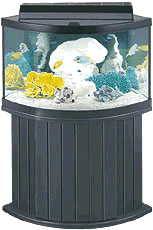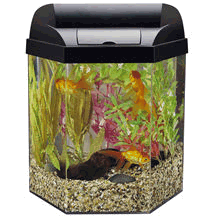TANK



Which tank to choose:
A beginner is confronted with a wide array
of tanks of different materials, sizes and shapes in a pet shop. A beginner always thinks that
small tanks are enough for him and as a starter he does not need big ones. Well that is the
first mistake all of us make. Each size of tank has its own special use. Smaller tanks are useful
in their own right, but not for the beginner. I would recommend a size of 3 ft x 1.5 ft x 1.5 ft.
You can do a calculation of how much volume of water this tank can contain. I have given below
a table of simple volume conversions and calculations. I recommend the user to get
familiar with the units such as cubic feet, gallons etc..This tank is not very expensive and
will form a good attraction among the living room decorations. Simple rectangular size tanks
are conventional and serve the purpose. There are also more attractive and expensive tanks
made to different shapes like hexagonal, triangular and many other shapes custom built to
fit the furniture of your home. If you cannot buy new tanks, you can always look for garage
sales, where lots of fish keepers give up the hobby due to lack of time or other factors and
you can strike a good bargain to get the complete set up including accessories for half the
price of new tank alone. But beware of leaks, you must check for leaks by asking the owner to
fill up the tank one day before you buy and check the next day for leaks. Used substrate should
be checked to see if it will suit your tank pH, as some substrate such as crushed coral can cause
the water to turn hard. It depends on what pH you want to keep in your tank. Used gravel if
purchased should be washed thoroughly with hot water before using.
You should remember that larger the surface area the more is the oxygen adsorption
and more number of fishes you can keep per gallon. For the same gallon capacity of water, a rectangular
tank can have much larger surface area than a square or hexagonal shaped tank which is taller.
I would recommend a simple rectangular tank for aquarium use, unless you want to decorate your
living room with a fashionable tank. Aquariums also come in Acrylic and Glass. Both have
their own advantages and disadvantages.
While smaller tanks will result in your fish having less space to swim about, it also means
less oxygen for the fishes. Often the beginner would soon go on a shopping spree, ending
up in more number of fish than the small tank can hold, resulting in an ultimate disaster.
Many beginners give up their hobby when this happens the second time they go on a shopping
spree. Some fishes can live in a Jam jar, while others need gallons of water. Bettas can
live in a Jam jar more than comfortably, where as gold fish as a rule need at least 10
gallons of water per fish. So be careful while selecting the tanks. I would advise you
decide on what kind fish you ultimately want to keep and then choose a tank. Also never buy
costly and more difficult fish to keep at first, just because you have purchased a large tank.
Start with smaller and easier fishes and few of them. Learn the water chemistry and habits
of fishes and then slowly go for more difficult ones to keep.
Unit Converter for Reference
| US Gallons
| Litres
| Cubic foot
|
| 1
| 4.4
| 0.1624
|
| 6.136
| 27
| 1
|
Formula
A Simple Formula for conversion of size to volume in the case of rectangular or square tanks is as follows:
GALLONS = {WIDTH X HEIGHT X LENGTH } / 231
All dimensions shall be in inches. Above formula is very handy.
Rectangular tanks
Typical Rectangular tank sizes and volumes available in the market are as follows:

| Volume (US G)
| Tank Size (inch)
| Application
|
| 10
| 20 x 10 x 12
| For small fish, Hospital tank, Breeding
|
| 15
| 24 x 12 x 12
| For small fish, Hospital tank, Breeding
|
| 15(high)
| 20 x 10 x 18
| For small fish, Hospital tank, Breeding
|
| 20(high)
| 24 x 12 x 16
| For medium fish, Breeding
|
| 20(Long)
| 30 x 12 x 12
| For medium fish, Breeding
|
| 25
| 24 x 12 x 20
| For medium fish, Breeding
|
| 30
| 36 x 12 x 16
| For medium fish, Breeding
|
| 40
| 36 x 18 x 16
| For big fish
|
| 40(long)
| 48 x 13 x 16
| For big fish
|
| 45
| 36 x 12 x 24
| For big fish
|
| 50
| 36 x 18 x 18
| For big fish
|
| 55
| 48 x 13 x 20
| For big fish
|
| 65
| 36 x 18 x 24
| For big fish
|
| 75
| 48 x 18 x 20
| For big fish
|
| 90
| 48 x 18 x 24
| For big fish
|
| 120
| 48 x 24 x 24
| For big fish
|
Hexagonal Tanks
Typical Hexagonal tank sizes and volumes available in the market are as follows:

| Volume (US G)
| Tank Size (inch)
| Application
|
| 10
| 14 x 12 x 18
| For small fish, Decorative
|
| 20
| 18 x 16 x 20
| For small fish, Decorative
|
| 35
| 23 x 20 x 24
| For medium fish, Decorative
|
| 60
| 27 x 24 x 28
| For medium fish, Decorative
|
Bow front Tanks



Typical Bowfront tanks have a curved front glass. These add to the beauty of the tank but has no real advantage over
simple rectangular tanks.
Selecting the Tank
Here are some tips for selecting the tanks whether new or old.
- The tank should not have bends or deformations in the glass used. When placed on a flat
surface it should not rock.
- The Glass should be of adequate thickness to withstand the pressure of water. For the size
of tank mentioned above the minimum thickness should be 5 mm. Thickness should be more for more
deeper tanks. There shall be no visible cracks.
- The sealant which is often silicone glue nowadays, should have been evenly applied and
well worked. There shall be no visible gaps in the glue.
- If buying used tanks always check for leaks. Never buy a leaking tank, unless you have
lots of patience to locate the leak and seal it. Ask the seller to fill it up with water and
keep it for a day before checking.
- If you are enterprising enough try to make your own small tanks. You can always buy
glass plates cut to the required size. Buy a silicone glue gun and some glue and there you are.
Be careful, silicone glue while curing releases acetic acid which can be dangerous if
inhaled too much or gets into the eye. Use rubber surgical glows.
- Other recommended sizes are
- 36 x 18 x 18
- 48 x 18 x 20
- 24 x 12 x 20
- If you really are having financial or space problems then get a 24 x 12 x 12 tank.
But beware of the number of fishes you can keep and the type of fishes.
- There are also many acrylic aquariums in the market. You have to be careful, acrylic
gets scratched easily and once it is scratched the visibility disappears and the charm of
the tank is gone. You have to clean the algae often with a razor blade and this you cannot
do to a acrylic surface. My preference would always be glass.
- If you have young children then please be careful about glass, as any banging on the
surface would very easily break the glass which is already under the pressure of the contained
water.
------------------ END -------------------